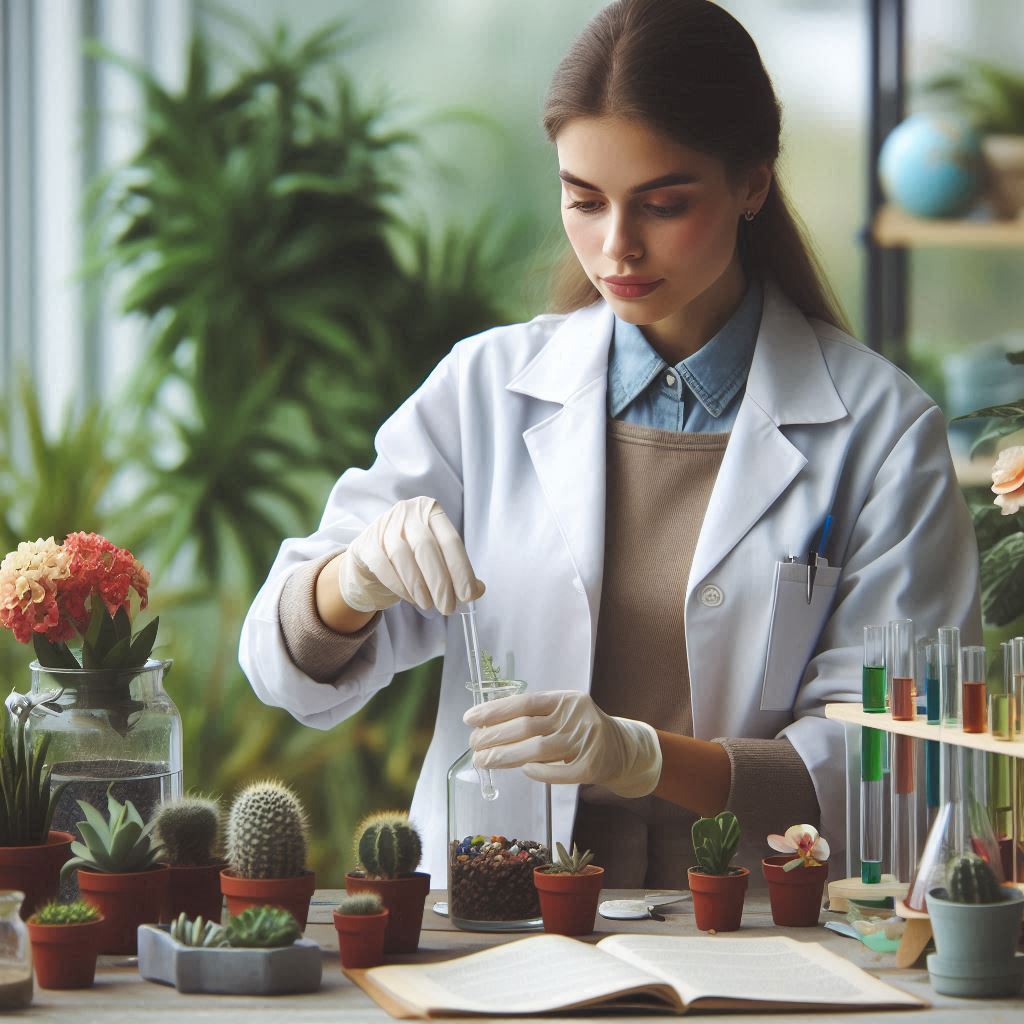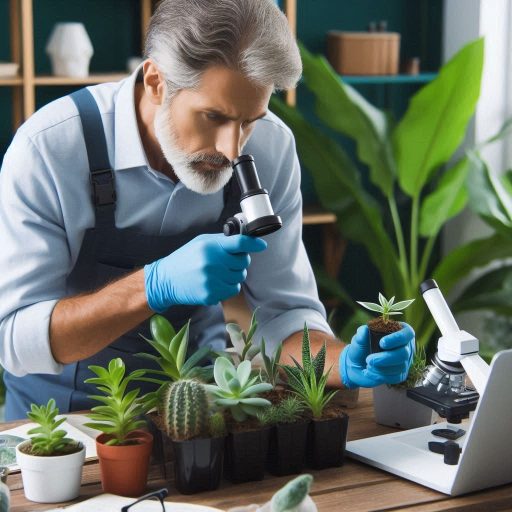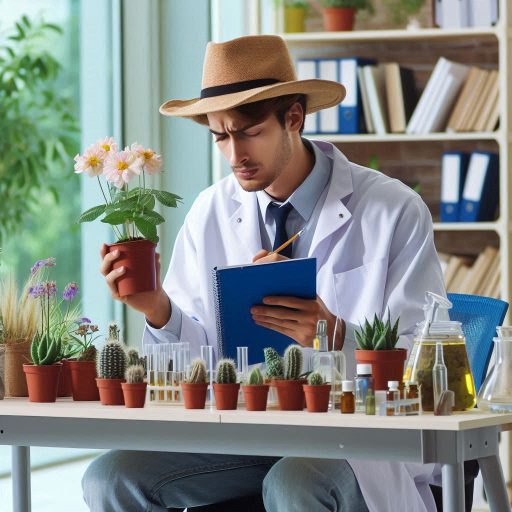Introduction
Herbarium collections are invaluable repositories of preserved plant specimens, meticulously gathered and stored for research and educational purposes.
Each specimen, often mounted on paper, includes detailed information about the plant’s origin, habitat, and morphological characteristics.
These collections encompass millions of specimens worldwide, representing a vast array of plant diversity across different ecosystems.
For botanists, herbarium collections hold significant importance.
They serve as essential resources for studying plant diversity, taxonomy, and evolution.
By examining preserved specimens, botanists accurately identify and classify plants.
This process enhances our understanding of global biodiversity.
Working with herbarium collections also enables botanists to document geographic distributions and ecological relationships.
This documentation is crucial for conservation efforts, as it highlights areas where plant species may be threatened or endangered.
In summary, herbarium collections play a pivotal role in botanical research and conservation.
They provide a wealth of information that supports biodiversity studies and habitat preservation efforts.
By actively working with these collections, botanists significantly enhance our understanding of the natural world.
What are herbarium collections?
Definition of Herbarium Collections
Herbarium collections serve as vital repositories of dried plant specimens, meticulously preserved, cataloged, and stored for scientific research and reference.
These collections play a vital role in botany.
They provide botanists and researchers with essential tools for studying plant diversity.
They also aid in examining plant distribution and evolution over time.
The specimens housed within herbaria capture a snapshot of biodiversity, offering invaluable insights into the planet‘s flora.
Herbarium collections help scientists compare different plant species.
This allows them to examine morphological traits and assess ecological relationships.
Researchers can also explore how plants adapt to varying environments.
These collections document the impacts of climate change and habitat loss on plant populations.
They serve as essential resources for conservation efforts.
Types of Specimens Found in Herbarium Collections
Herbarium collections encompass a diverse array of specimens, each serving a unique purpose in botanical research.
The most common types include:
- Pressed Plants: Pressed plants represent the cornerstone of herbarium collections.
These specimens are carefully collected, pressed, and dried to maintain their natural shape and structure.
Each specimen retains essential characteristics like leaf arrangement, flower morphology, and overall size.
These traits are critical for identification and study. - Seeds: In addition to pressed plants, herbarium collections often contain seeds from various plant species.
These seeds are stored in envelopes or small containers, preserving their viability for future study.
By examining seeds, researchers can learn about germination patterns, reproductive strategies, and evolutionary adaptations. - Fruits: Some herbarium collections also include specimens of fruits from different plant species.
These preserved fruits are valuable for studying dispersal mechanisms, seed development, and plant reproductive strategies.
By analyzing fruit morphology, botanists can gain insights into ecological relationships and plant-animal interactions. - Pollen: Pollen samples are another important component of herbarium collections.
These samples are used to study plant reproductive biology, pollination ecology, and evolutionary relationships among species.
By analyzing pollen grains, researchers can gain insights into past climates and environments, as well as track changes in plant communities over time.
How Herbarium Collections are Organized and Maintained
Herbarium collections follow strict protocols for organization and maintenance.
These protocols keep specimens in optimal condition.
They also ensure easy accessibility for research purposes.
The organization and maintenance of these collections are crucial for preserving their scientific integrity.
Organization
- Accessioning: Each specimen gets a unique accession number. This number connects it to detailed information about the plant species.
The information includes its geographic location, the collector, and the date of collection.
This information is critical for tracking the specimen’s history and for understanding its ecological context. - Taxonomic Arrangement: Specimens typically arrange according to their taxonomic classification.
They start with simpler organisms like algae. Next, they proceed to more complex groups, including mosses and ferns.
This hierarchical organization facilitates research by providing a systematic framework for locating specimens. - Alphabetical Organization: Within each taxonomic group, specimens are further organized alphabetically by family, genus, and species.
This organization system allows researchers to efficiently locate specific specimens based on their taxonomic identity, streamlining the research process.
Maintenance
- Storage Conditions: Researchers store specimens in specially designed cabinets or herbarium cases.
These cabinets protect specimens from light, humidity, pests, and temperature fluctuations.
Proper storage is essential for preventing degradation and ensuring the long-term preservation of specimens. - Regular Inspections: To prevent damage from insects, fungi, and other potential threats, herbarium collections are regularly inspected.
Preservation techniques, like insecticidal treatments and antifungal agents, treat specimens to mitigate risks.
These methods help maintain specimen integrity effectively. - Detailed Record Keeping: Preservation techniques, like insecticidal treatments and antifungal agents, treat specimens to mitigate risks.
These methods help maintain specimen integrity effectively..
These records are essential for tracking the usage and condition of specimens, as well as for facilitating collaborative research efforts.
Working with herbarium collections as a botanist provides invaluable insights into plant diversity, distribution, and evolutionary relationships.
The meticulous organization and maintenance of these collections ensure their continued utility for scientific research.
By following established protocols and best practices, botanists can unlock the secrets hidden within these invaluable repositories of botanical knowledge.
Herbarium collections not only preserve the legacy of plant diversity but also serve as crucial tools for addressing contemporary environmental challenges.
Importance of Herbarium Collections for Botanists
Herbarium collections play a vital role in botanical research.
These collections consist of preserved plant specimens that provide essential data for various scientific studies.
Understanding their significance helps botanists appreciate the value of herbariums.
Role of Herbarium Collections in Botanical Research
Herbarium collections serve several important functions:
- Documentation of Plant Diversity: Botanists use herbarium specimens to document and study plant diversity.
These collections help track species distribution and abundance over time. - Research and Education: Herbarium collections facilitate research and education.
They provide resources for students, researchers, and the public to learn about plant species. - Conservation Efforts: Botanists rely on herbarium specimens to support conservation efforts.
These collections help identify endangered species and inform preservation strategies. - Taxonomy and Systematics: Herbarium specimens play a crucial role in taxonomy and systematics.
Botanists use them to classify plants and understand evolutionary relationships.
Use of Herbarium Collections in Species Identification
Botanists frequently use herbarium collections for species identification.
These collections offer valuable reference points for accurate identification.
Here are some key uses:
- Comparative Analysis: Botanists compare specimens to identify unique features.
This process helps differentiate between closely related species. - Morphological Studies: Herbarium specimens allow for detailed morphological studies.
Botanists analyze characteristics like leaf shape, flower structure, and seed type. - Geographic Distribution: Herbarium collections provide data on plant distributions.
This information helps botanists understand habitat preferences and range limits. - Ecological Research: Herbarium specimens support ecological research.
They provide insights into species interactions and ecosystem dynamics over time.
Preservation of Plant Specimens for Future Generations
The preservation of plant specimens in herbarium collections is crucial.
It ensures that future generations can access valuable scientific data.
Here are some important aspects of preservation:
- Long-term Storage: Proper storage techniques extend the lifespan of herbarium specimens.
Botanists use acid-free materials and controlled environments for preservation. - Digitalization Efforts: Many herbaria are digitizing collections for broader access.
Digital records enhance data sharing and collaborative research opportunities. - Educational Outreach: Preserved specimens serve as educational tools.
They help raise awareness about plant diversity and the importance of conservation. - Scientific Research: Herbarium specimens are vital for ongoing scientific research.
They provide baseline data for studies on climate change, invasive species, and biodiversity loss.
Herbarium collections hold significant importance for botanists.
They facilitate research, species identification, and preservation efforts.
By understanding their value, botanists can continue to advance the field of botany and contribute to environmental conservation.
Read: Biology Ethics: Navigating Complex Issues in the US
Accessing and using herbarium collections
Herbarium collections are invaluable resources for botanists.
These collections house preserved plant specimens, providing critical data for research.
Understanding how to access and use these collections is essential for effective botanical study.
Searching for Specimens
Botanists can search for specimens in herbarium collections through various methods:
- Online Databases: Most herbaria maintain online databases.
These databases allow researchers to search by species, family, or collection date. - Field Guides: Field guides help identify specific plant species.
These guides often include information on herbarium specimens. - Networking with Other Botanists: Engaging with other botanists can lead to specimen discovery.
Collaborating with colleagues often uncovers hidden resources.
Using these methods, botanists can efficiently locate specimens relevant to their research.
Protocols for Handling Specimens
Proper protocols are crucial when handling herbarium specimens.
Following these guidelines ensures specimen integrity and quality:
- Wear Gloves: Always wear gloves when handling specimens.
This practice prevents oils and dirt from damaging them. - Use Tweezers: Use tweezers for delicate specimens.
This method minimizes the risk of damage during handling. - Maintain a Clean Workspace: Keep work areas free of contaminants.
A clean environment protects the specimens from potential harm. - Document Everything: Record all observations and changes made to specimens.
Detailed documentation aids future research efforts.
These protocols help preserve the integrity of herbarium specimens for future studies.
Tools and Resources for Studying Herbarium Collections
Several tools and resources assist botanists in studying herbarium collections:
- Microscopes: Microscopes enable detailed examination of specimens.
They allow for the study of fine morphological features. - Software for Data Analysis: Software tools like R or Python can analyze specimen data.
These tools support statistical analyses and visualization. - Photography Equipment: High-quality cameras capture images of specimens.
This documentation aids in species identification and research presentations. - Herbarium Manuals: Manuals provide guidelines on best practices for specimen collection and identification.
They serve as reference materials for best methods. - Field Apps: Many mobile apps assist in plant identification.
These apps provide real-time data collection during fieldwork.
Utilizing these tools enhances a botanist’s ability to study herbarium collections effectively.
Accessing and using herbarium collections is vital for botanists.
By efficiently searching for specimens, following proper protocols, and utilizing the right tools, researchers can maximize their studies.
This approach not only enriches their research but also contributes to the broader field of botany.
Embracing these practices will lead to more meaningful discoveries and a deeper understanding of plant diversity.
Read: Continuous Learning: Post-graduate Options for US Biologists
Transform Your Career Today
Unlock a personalized career strategy that drives real results. Get tailored advice and a roadmap designed just for you.
Start NowConducting research using herbarium collections
Herbarium collections play a crucial role in botanical research.
They preserve plant specimens and serve as vital resources for various studies.
Botanists can conduct a wide range of research projects using these collections.
This section explores examples of research, how botanists can contribute, and ways to enhance the visibility and accessibility of herbarium collections.
Examples of Research Projects
- Taxonomic Studies: Botanists use herbarium specimens to study plant classification and relationships.
They analyze morphological features to refine taxonomic categorizations. - Ecological Research: Researchers examine herbarium collections to understand plant distributions and habitat preferences.
They can identify shifts in species ranges over time. - Climate Change Studies: Botanists analyze herbarium specimens to study historical plant responses to climate change.
They track phenological changes in flowering and fruiting times. - Conservation Efforts: Herbarium collections provide data for assessing the conservation status of plant species.
Researchers can identify endangered species and prioritize conservation actions. - Pharmacognosy: Some studies focus on the medicinal properties of plants.
Botanists examine specimens to document traditional uses and identify bioactive compounds.
Contributing to the Development of Herbarium Collections
Botanists can enhance herbarium collections in several ways:
- Collecting Specimens: Actively collecting new specimens helps maintain and diversify herbarium collections.
Botanists should follow proper collection protocols to ensure specimen quality. - Data Entry and Curation: Contributing to data entry and curation improves the organization of collections.
Accurate labeling and documentation make specimens more accessible for research. - Collaboration: Partnering with other institutions fosters the sharing of knowledge and resources.
Collaboration enhances the overall quality and reach of herbarium collections. - Outreach and Education: Engaging the public and students increases awareness of herbarium collections.
Educational programs can inspire future botanists and promote conservation efforts.
Increasing Visibility and Accessibility
Enhancing the visibility and accessibility of herbarium collections is vital for research advancement.
Here are some strategies:
- Digitalization: Digitizing herbarium specimens makes them accessible to a broader audience.
Online databases allow researchers to access valuable information remotely. - Online Databases: Establishing online databases enhances searchability.
Researchers can quickly locate specific specimens or relevant data for their studies. - Collaborative Networks: Joining regional or international herbarium networks increases visibility.
Collaborating with other herbaria can lead to shared resources and research opportunities. - Public Exhibits: Organizing public exhibits showcases herbarium collections.
These exhibits can educate the community and highlight the importance of plant diversity.
Conducting research using herbarium collections opens doors to numerous scientific inquiries.
By actively participating in the development and promotion of these collections, botanists can significantly contribute to the field.
Increasing visibility and accessibility enhances research opportunities and fosters greater appreciation for plant biodiversity.
Read: Essential Skills and Tools for Modern Chemists in America

Challenges and Limitations of Working with Herbarium Collections
Botanists face various challenges when working with herbarium collections.
Understanding these challenges helps researchers develop effective strategies for overcoming them.
Here are the key challenges and limitations:
Specimen Preservation and Deterioration
Preserving herbarium specimens requires careful attention.
Improper storage conditions can lead to deterioration.
Here are some common issues related to specimen preservation:
- Insect Infestation: Pests can damage specimens, causing loss of important data.
- Fungal Growth: Humidity and poor ventilation can foster mold, which deteriorates specimens.
- Physical Damage: Handling can lead to tears, fading, or loss of fragile specimens.
- Chemical Degradation: Exposure to light or pollutants can degrade paper and colors over time.
To mitigate these issues, botanists must implement strict preservation protocols.
Regular inspections and appropriate storage environments are essential.
Funding and Resources
Maintaining herbarium collections requires significant funding and resources.
Many institutions face budget constraints that affect their ability to care for specimens.
Key resource challenges include:
- Financial Support: Limited funding can restrict hiring qualified staff for collection maintenance.
- Equipment Needs: High-quality storage materials and preservation equipment can be costly.
- Research Funding: Lack of grants for herbarium-related research hampers scientific progress.
Botanists must advocate for increased funding and explore partnerships with organizations that support botanical research.
Collaborating with universities and private institutions can also help secure necessary resources.
Addressing Biases and Gaps
Herbarium collections often contain biases that affect research outcomes.
These biases can limit our understanding of biodiversity and plant distribution.
Here are some common issues:
- Geographical Bias: Many collections over-represent certain regions, neglecting others.
- Taxonomic Gaps: Some taxa may be underrepresented, limiting ecological and evolutionary studies.
- Historical Bias: Specimens collected in the past may not reflect current biodiversity accurately.
To address these biases, botanists must prioritize inclusivity in collection practices.
They should actively seek specimens from underrepresented regions and taxa.
Collaboration with local communities can help gather diverse data, enriching the collections.
Working with herbarium collections presents several challenges for botanists.
Issues related to specimen preservation, funding, and biases can hinder research progress.
By recognizing and addressing these limitations, botanists can enhance the value of herbarium collections.
Efforts to improve preservation methods, secure funding, and diversify collections will foster more comprehensive botanical research.
Ultimately, addressing these challenges will lead to a deeper understanding of plant biodiversity and conservation needs.
Read: The Role of Chemists in US Environmental and Sustainability Efforts
Professional development opportunities for botanists working with herbarium collections
Training programs and workshops on herbarium techniques
Botanists working with herbarium collections can benefit greatly from attending specialized training programs and workshops.
These opportunities provide hands-on experience and knowledge sharing among experts in the field.
By participating in these events, botanists can enhance their skills and stay updated on the latest techniques and best practices in herbarium management.
These training programs cover a wide range of topics.
They include plant specimen preservation, digitization techniques, data management, and specimen identification.
Botanists can learn how to properly collect, process, mount, and store plant specimens, ensuring their long-term preservation and accessibility for research purposes.
Additionally, workshops on herbarium techniques offer botanists the chance to network with colleagues and experts in the field.
They can exchange ideas, collaborate on projects, and share their knowledge and experiences.
These interactions can lead to valuable partnerships and collaborations, ultimately enhancing the quality and impact of their research work.
Collaborative projects with other institutions and researchers
Herbarium collections offer botanists valuable opportunities for professional development.
They can engage in collaborative projects with other institutions and researchers.
These collaborations enhance their skills and expand their networks.
By partnering with museums, botanical gardens, universities, and research institutions, botanists can access a wealth of resources and expertise to advance their work.
Collaborative projects allow botanists to work on larger-scale research endeavors, pooling their knowledge and skills with those of their collaborators.
They can tackle complex research questions, exchange data and specimens, and leverage each other’s strengths to achieve common goals.
These partnerships can lead to groundbreaking discoveries and innovative solutions to pressing challenges in botany.
Collaborative projects enable botanists to publish their research findings in peer-reviewed journals.
They also allow botanists to present their work at conferences and seminars.
Co-authoring papers with other researchers helps botanists increase their work’s visibility and impact.
This collaboration reaches a broader audience and advances the field.
These publications and presentations enhance their professional reputation and credibility, opening up new career opportunities and collaborations.
Publishing and presenting research based on herbarium collections
One of the key professional development opportunities for botanists working with herbarium collections is publishing and presenting their research findings.
Botanists share their discoveries and insights with the scientific community through peer-reviewed journals.
They present their work at conferences and seminars. This dissemination also reaches the general public.
Publishing research based on herbarium collections allows botanists to enhance botanical knowledge.
They document plant species, describe new taxa, and highlight biodiversity conservation issues.
They can publish their findings in high-impact journals, increasing the visibility and credibility of their work and attracting collaborators and funding opportunities.
Presenting research at conferences and seminars allows botanists to showcase their work.
They can receive feedback from peers and engage in discussions about their findings.
They can network with other researchers, build collaborations, and stay informed about the latest trends and developments in the field.
Presenting research also enhances their communication skills, as they learn to effectively convey complex scientific concepts to diverse audiences.
Professional development opportunities help botanists working with herbarium collections advance their careers.
They also expand their knowledge and skills.
These opportunities enable them to make meaningful contributions to the field of botany.
Botanists can enhance their careers by participating in training programs and collaborative projects.
These activities help them grow professionally and become leaders in their field.
By doing so, they drive innovation and progress in botanical science.
Find Out More: Prominent Soil Science Laboratories in the USA
You Might Also Like: Materials Science: Contributions to Medicine and Healthcare
Promoting Public Engagement and Education with Herbarium Collections
Herbarium collections play a vital role in botanical research and education.
Promoting public engagement enhances awareness and appreciation for these collections.
Here are several effective strategies to increase public involvement and education regarding herbarium collections.
Transform Your Career Today
Unlock a personalized career strategy that drives real results. Get tailored advice and a roadmap designed just for you.
Start NowOutreach Programs
Outreach programs significantly boost awareness of herbarium collections.
They can target schools, community organizations, and local events.
Consider these outreach initiatives:
- Workshops and Lectures: Host events that showcase the importance of herbarium collections.
Invite botanists to speak about their work and findings. - School Partnerships: Collaborate with local schools to introduce herbarium concepts.
Offer guided tours or interactive sessions for students. - Community Events: Set up booths at community fairs and festivals.
Use engaging activities to explain the significance of plant specimens.
Educational Resources
Developing educational resources is essential for fostering understanding.
Accessible materials can cater to various audiences, including students and the general public.
Consider these options:
- Online Platforms: Create websites and social media pages featuring herbarium collections.
Include interactive tools like virtual tours and specimen databases. - Printed Materials: Produce brochures, posters, and infographics.
These should explain the value of herbarium specimens and their role in research. - Curriculum Guides: Design curriculum materials for teachers.
These guides can incorporate herbarium collections into science lessons.
Integrating Collections into Botanical Gardens and Museums
Integrating herbarium collections into botanical gardens and museums creates dynamic educational experiences.
Visitors can learn about plants in context.
Here are some integration ideas:
- Exhibits: Set up permanent or temporary exhibits showcasing herbarium specimens.
Highlight their importance in understanding biodiversity and conservation. - Interactive Displays: Create interactive stations where visitors can engage with specimens.
Allow them to explore and learn about various plant species. - Guided Tours: Offer guided tours that include herbarium collection highlights.
Educators can explain the significance of the specimens and their scientific value.
Promoting public engagement and education with herbarium collections is crucial for fostering appreciation and understanding.
We can enhance public awareness by implementing outreach programs.
Developing educational resources also plays a vital role.
Additionally, integrating collections into botanical gardens and museums will increase visibility.
These efforts can inspire future generations to value plant diversity and conservation.
Engaging the public will ensure that herbarium collections continue to be recognized as essential resources in the field of botany.
Together, we can cultivate a deeper connection between people and the natural world through these unique and invaluable collections.
Conclusion
Working with herbarium collections is vital for botanists.
These collections preserve plant specimens, which aids in research, education, and conservation efforts.
Herbarium collections serve as valuable references for identifying species and understanding biodiversity across various ecosystems.
Botanists should actively contribute to herbarium collections.
Sharing findings and adding new specimens enriches our understanding of global flora.
Engaging in collaborative efforts with herbaria fosters a sense of community among researchers and promotes advancements in plant sciences.
The future of herbarium collections looks promising, with technological advancements transforming how we utilize these resources.
Digital databases and imaging technologies improve accessibility and usability for researchers worldwide.
Innovations in genetic analysis and data integration will enhance our research capabilities and deepen our understanding of plant species.
As botanists, we must embrace these advancements and advocate for the importance of herbarium collections in our work.
Let‘s work together to preserve plant diversity and advance botanical knowledge for future generations.
By contributing to and utilizing herbarium collections, we can play a crucial role in the ongoing efforts to understand and protect our planet‘s flora.




